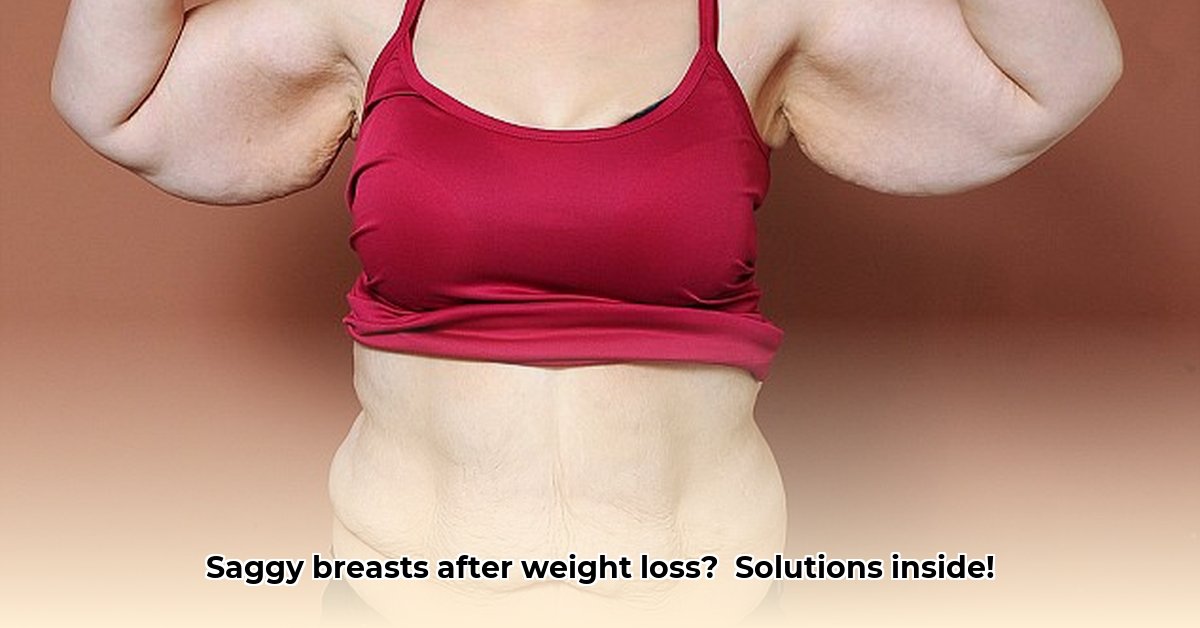
Losing weight is a significant achievement, but it can sometimes lead to unexpected changes in your body, including breast sagging. This is a common concern, and understanding the causes and available solutions is crucial for maintaining confidence and overall well-being. For more before & after examples, see this helpful resource. This article provides comprehensive information and practical guidance on addressing this issue.
Understanding Breast Sagging After Weight Loss
Weight loss, particularly substantial weight loss, reduces breast volume. Breasts are primarily composed of fatty tissue and glandular tissue; when you lose weight, fat is shed from all areas of the body, including the breasts. This reduction in volume, combined with the natural loss of skin elasticity (a process accelerated by rapid weight loss), contributes to sagging. The extent of sagging depends on various factors, including the amount and rate of weight loss, genetics, age, and pre-existing breast size. It's important to remember this is a normal consequence of weight loss for many women.
Factors Contributing to Sagging
Several factors interact to influence how your breasts change after weight loss:
- Genetics: Skin elasticity is partially determined by genetics. Some individuals naturally have more elastic skin than others.
- Rate of Weight Loss: Rapid weight loss dramatically reduces breast volume quickly, leaving skin less time to adapt, leading to more noticeable sagging. Gradual weight loss is key.
- Age: As we age, skin loses elasticity, making it more prone to sagging after any significant weight fluctuation.
- Pregnancy: Prior pregnancies can also affect breast tissue elasticity.
- Breast Size: Larger breasts tend to be more susceptible to sagging due to their weight.
Preventing Breast Sagging: A Proactive Approach
While some degree of sagging may be unavoidable after significant weight loss, proactive measures can minimize its impact. The key is to focus on healthy, gradual weight loss and strengthening supporting muscles.
Strategies for Prevention
The most effective strategies for preventing breast sagging involve:
Gradual Weight Loss: Aim for a slow and steady weight loss of 1-2 pounds per week. This allows the skin to adapt gradually, reducing the likelihood of extreme sagging.
Strength Training: Strengthening your pectoral muscles improves breast support. Incorporate exercises such as push-ups, dumbbell presses, and chest flyes into your workout routine (2-3 times per week).
Supportive Bras: Wear a well-fitting, supportive bra throughout the day, particularly during exercise. This helps minimize breast movement and strain.
Topical Treatments: Some studies suggest that certain topical treatments, like creams containing retinoids or antioxidants, may improve skin elasticity. However, more research is needed, and consulting a dermatologist is essential before using any new product. (Note: Efficacy varies significantly.)
Healthy Diet and Lifestyle: A balanced diet rich in protein, antioxidants, and healthy fats supports overall skin health and well-being. Maintaining hydration is also crucial for skin elasticity.
Data-backed Rhetorical Question: Considering the significant impact of gradual weight loss, wouldn't prioritizing a slower, healthier approach be beneficial for both weight management and breast health?
Addressing Existing Sagging: Options to Consider
If you're already experiencing breast sagging after weight loss, various options can help improve their appearance. These range from non-surgical methods to surgical procedures.
Non-Surgical Options
A few non-surgical options might offer some improvement; however, results vary and are often subtle.
- Specialized Creams: These are readily available and relatively inexpensive. However, effectiveness can be limited and results inconsistent.
- Massage Therapy: Regular massage may improve circulation and potentially skin tone, but it’s unlikely to significantly reduce sagging.
- Radiofrequency Treatments: These treatments aim to stimulate collagen production and improve skin elasticity. While promising, they often require multiple sessions and can be expensive.
Quantifiable Fact: Studies have shown varying degrees of success for radiofrequency treatments, with improvements ranging from minimal to moderate depending on individual factors.
Surgical Options
For more significant improvements, surgical interventions are an option. These should be discussed with a qualified plastic surgeon to ensure they are the right choice for you.
- Breast Lift (Mastopexy): This procedure lifts and reshapes the breasts by removing excess skin and tightening underlying tissue. It does not increase breast size.
- Breast Augmentation (Implants): Augmentation involves placing implants to increase breast size and firmness; it can be combined with a mastopexy for optimal results.
Expert Quote: "Surgical options, such as mastopexy or augmentation, offer more dramatic results but carry inherent surgical risks and necessitate thorough consultation with a qualified plastic surgeon," states Dr. Anya Sharma, board-certified plastic surgeon at [Hospital Name].
Lifestyle Choices for Long-Term Breast Health
Regardless of the chosen approach, maintaining a healthy lifestyle significantly contributes to long-term breast health:
- Balanced Diet: Continue to eat a nutritious diet that supports overall health and skin elasticity.
- Regular Exercise: Maintain regular exercise to strengthen muscles and maintain overall body health.
- Supportive Bras: Continue wearing supportive bras for optimal breast support.
Seek Professional Guidance
This information is for educational purposes only and does not constitute medical advice. Always consult your doctor or a qualified healthcare professional before making any decisions related to your health or weight loss. They can assess your individual circumstances and provide personalized recommendations.
Call to Action: Schedule a consultation with your physician or a board-certified plastic surgeon to discuss your concerns and explore the best options for you.